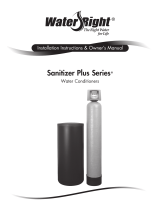2
Description of the system
The PNR1 system includes a mineral tank (with gravel, distributor and nitrate selective anion resin), brine tank
(with salt shelf, brine well, brine tank lid and safety brine valve), a mineral tank with digital backwashing control
valve with bypass valve, plumbing adapters, drain line and brine line.
Successful Application
The PNR1 system is designed to reduce nitrate, sulfate and chloride levels in potable water through anion
exchange. Water softener salt is required to regenerate the anion resin, but the PNR1 is NOT A WATER
SOFTENER. It exchanges chloride (taken from the brine used for regeneration) for nitrate, sulfate and fluoride
anions. The water being supplied to the PNR1 system must be; soft, iron free, manganese free, tannin free,
have less than 0.5 ppm chlorine and be filtered to 5 microns. Pre-treatment equipment is always required and
post-treatment with reverse osmosis may be required if TDS level exceeds 500 ppm after treatment or if a salty
taste occurs when used in combination with a softener due to the addition of sodium and chloride to the drinking
water.
Time of Regeneration
Periodically the control valve will go through regeneration. Regeneration is factory preset to 3:30 A.M. The time
of regeneration may be changed if needed (see programming procedures on pages 9 - 10).
Location Considerations
The proper location to install the system will ensure optimum performance and satisfactory water quality. The
following factors should be considered in selecting the location of this system.
1. The system must be installed after the pressure tank (private well system only).
2. The system should be installed after any other water treatment equipment except reverse osmosis.
3. If chlorine is present in the supply water a whole house carbon filter should be installed before the
system.
4. The system must not be subject to freezing temperatures.
5. Ensure that any in-line filter installed prior to the system does not restrict the flow or pressure required
to backwash the system.
6. The system should be installed as close as possible (preferably within 15’) to an adequate floor or
laundry drain capable of handling the backwash cycle volume and flow rate (refer to unit
specifications on page 11). An air gap should be provided between the drain line and plumbing drain.
7. All water conditioning equipment should be installed at least 10’ prior to the water heater. Water
temperatures exceeding 100°F can damage the internal components of the control valve and mineral
tank. An expansion tank may need to be installed in the line to the water heater in order to allow for
thermal expansion and comply with local plumbing codes.
8. Appliances requiring extended periods of continuous or high flow water use (i.e. geothermal heat
pumps, swimming pools, lawn irrigation, outside hose bibs, etc.) should bypass all water conditioning
equipment unless the equipment has been specifically designed for that purpose.
























